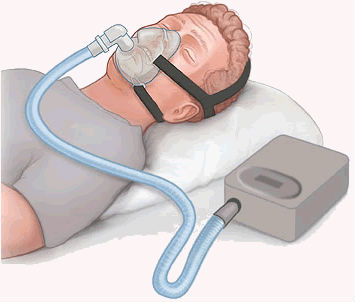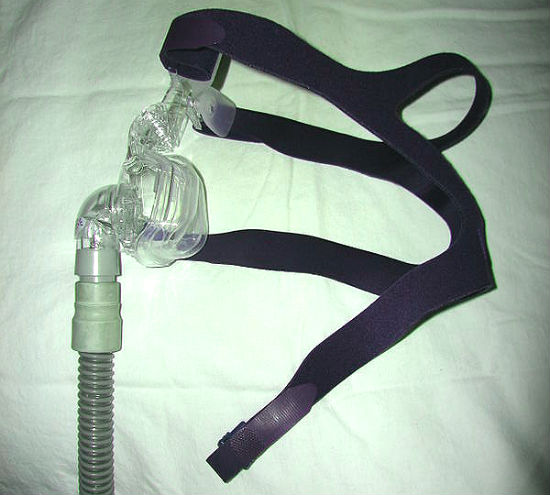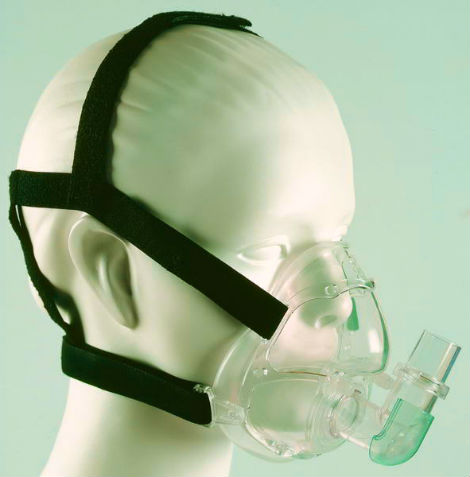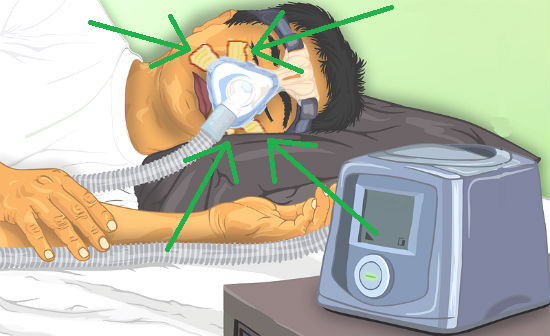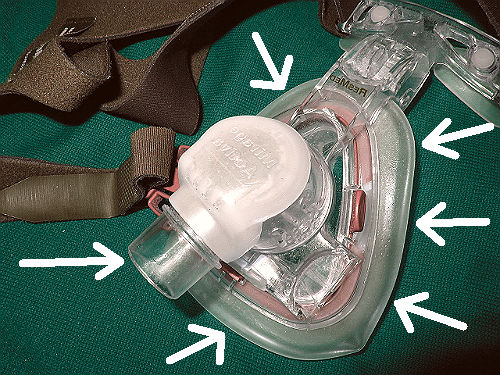Använder du en mobil enhet ? - dubbelklicka i detta område, så blir texten större ! Do you use a mobile unit ? - For larger text, doubleclick in this area !
- Article on how to use a CPAP / BiPap home respirator -
Need to use a fan?
But not sure how to do it?
We go through how to use a portable breathing apparatus!
Maybe you have a CPAP / BiPap fan printed, but need some additional information on how to use it?
A ventilator is an apparatus used by people who suffer from snoring problems (sleep apnea), general respiratory problems, or who have had a muscular disease and thus do not have the ability to fully breathe themselves. Fans can also be used by people with severe fluid deficiency, as some fans provide extra water to the body. The use of fans is more common than you think.
Picture of a person sleeping with a fan, with associated respiratory mask
Often you get a portable ventilator printed by your doctor, which you should use in your home, but the information on how to actually use the respirator is often deficient. This can result in facial ulcers, swollen face, poor oxygen supply and other discomfort.
We will now give you some general advice, which usually applies to most respirators.
Basic Principle:
Put on the respirator over the face – activate the fan – check the tightness of the mask – check the morning use report
Here’s how – 8 tips:
1. How to put on the respirator:
The principle here is to first loosen a pair of straps and then put the respirator over the face / head. When the respirator sits where it should, you can also attach the remaining straps:
- Article on how to use a CPAP / BiPap home respirator -
Need to use a fan?
But not sure how to do it?
We go through how to use a portable breathing apparatus!
Maybe you have a CPAP / BiPap fan printed, but need some additional information on how to use it?
A ventilator is an apparatus used by people who suffer from snoring problems (sleep apnea), general respiratory problems, or who have had a muscular disease and thus do not have the ability to fully breathe themselves. Fans can also be used by people with severe fluid deficiency, as some fans provide extra water to the body. The use of fans is more common than you think.
Picture of a person sleeping with a fan, with associated respiratory mask
Often you get a portable ventilator printed by your doctor, which you should use in your home, but the information on how to actually use the respirator is often deficient. This can result in facial ulcers, swollen face, poor oxygen supply and other discomfort.
We will now give you some general advice, which usually applies to most respirators.
Basic Principle:
Put on the respirator over the face – activate the fan – check the tightness of the mask – check the morning use report
Here’s how – 8 tips:
1. How to put on the respirator:
The principle here is to first loosen a pair of straps and then put the respirator over the face / head. When the respirator sits where it should, you can also attach the remaining straps:
Picture of a breathing mask with the left lower strap loose
2. So the breathing mask should sit:
The mask should sit hard against the face, otherwise the air will leak and may eventually cause sores on the face and eye problems, because the pressure of the air is so severe. The most difficult thing is often to tighten the lower belts hard enough. It is also important to keep your mouth closed when the respirator is on, otherwise the air will press on the teeth and this can be very unpleasant:
Instructional image of how a full-face mask should fit
3. How do you know if you have put on the face mask correctly?
- You can’t know that in advance. When you turn off your fan in the morning, you get a report that tells you how the air closure and fluid supply have been during the night. You can then learn some lessons from that report.
4. Check the tightness of the respirator:
After you put the respirator over your face and put it on your fan, there is a button that you can press to check that the mask is snug. However, the tightness of the mask is no guarantee that you will receive an approved usage report in the morning.
5. About turning off the fan when the mask is on:
The fan can be turned off while the respirator is still sitting on one person. There are air holes in the mask that allow you to breathe anyway.
6. Reduce the swelling / redness of the face:
When using a ventilator with a respirator, there is the risk of being swollen on the face. The reason for this is that some of the air usually leaks and blows around in the wrong places, instead of going down into the lungs. You simply get “bloated” in the face. To reduce the swelling, you can use small facial pads that are applied to the places where the air usually exudes, or where the respirator usually scratches the face:
Picture of a person sleeping with a breathing mask, where four pillows for pressure relief under the mask have been fixed
7. Add water during the night:
If you have a fan with a liquid container, you may need to add water a couple of times during the night. A water tank usually lasts between four and seven hours. But how long the water in the tank lasts, usually varies throughout the year. If the fan operates without water in the tank, the fan may start to “warm up”.
8. How to clean the respirator / water container:
A fan requires daily proper cleaning. When removing the mask in the morning, it is often full of mucus and coatings. You can clean the mask with detergent, water and disinfectant. On some masks it is possible to unbutton the outermost rubber nozzle on the mask to get clean. The water tank can also be cleaned in the same way:
The white arrows show where you may need to clean the respirator
.
More information about the article:
We have noticed that many people who have had a fan printed have no deeper information on how to deal with the fan / respirator.
This is because the healthcare professional who has printed the mask often lacks the technical or pedagogical skills to teach how to use the ventilator, and that the manuals that come with these ventilators are not sufficiently detailed.
This often results in facial ulcers, swollen eyes / face, and poor oxygen supply.
The solution to the problem is often to learn all the fan functions in detail.
The examination of the fans didWe go through how to use a portable breathing apparatus!
Maybe you have a CPAP / BiPap fan printed, but need some additional information on how to use it?
A ventilator is an apparatus used by people who suffer from snoring problems (sleep apnea), general respiratory problems, or who have had a muscular disease and thus do not have the ability to fully breathe themselves. Fans can also be used by people with severe fluid deficiency, as some fans provide extra water to the body. The use of fans is more common than you think.
Picture of a person sleeping with a fan, with associated respiratory mask
Often you get a portable ventilator printed by your doctor, which you should use in your home, but the information on how to actually use the respirator is often deficient. This can result in facial ulcers, swollen face, poor oxygen supply and other discomfort.
We will now give you some general advice, which usually applies to most respirators.
Basic Principle:
Put on the respirator over the face – activate the fan – check the tightness of the mask – check the morning use report
Here’s how – 8 tips:
1. How to put on the respirator:
The principle here is to first loosen a pair of straps and then put the respirator over the face / head. When the respirator sits where it should, you can also attach the remaining straps:
Picture of a breathing mask with the left lower strap loose
2. So the breathing mask should sit:
The mask should sit hard against the face, otherwise the air will leak and may eventually cause sores on the face and eye problems, because the pressure of the air is so severe. The most difficult thing is often to tighten the lower belts hard enough. It is also important to keep your mouth closed when the respirator is on, otherwise the air will press on the teeth and this can be very unpleasant:
Instructional image of how a full-face mask should fit
3. How do you know if you have put on the face mask correctly?
- You can’t know that in advance. When you turn off your fan in the morning, you get a report that tells you how the air closure and fluid supply have been during the night. You can then learn some lessons from that report.
4. Check the tightness of the respirator:
After you put the respirator over your face and put it on your fan, there is a button that you can press to check that the mask is snug. However, the tightness of the mask is no guarantee that you will receive an approved usage report in the morning.
5. About turning off the fan when the mask is on:
The fan can be turned off while the respirator is still sitting on one person. There are air holes in the mask that allow you to breathe anyway.
6. Reduce the swelling / redness of the face:
When using a ventilator with a respirator, there is the risk of being swollen on the face. The reason for this is that some of the air usually leaks and blows around in the wrong places, instead of going down into the lungs. You simply get “bloated” in the face. To reduce the swelling, you can use small facial pads that are applied to the places where the air usually exudes, or where the respirator usually scratches the face:
Picture of a person sleeping with a breathing mask, where four pillows for pressure relief under the mask have been fixed
7. Add water during the night:
If you have a fan with a liquid container, you may need to add water a couple of times during the night. A water tank usually lasts between four and seven hours. But how long the water in the tank lasts, usually varies throughout the year. If the fan operates without water in the tank, the fan may start to “warm up”.
8. How to clean the respirator / water container:
A fan requires daily proper cleaning. When removing the mask in the morning, it is often full of mucus and coatings. You can clean the mask with detergent, water and disinfectant. On some masks it is possible to unbutton the outermost rubber nozzle on the mask to get clean. The water tank can also be cleaned in the same way:
The white arrows show where you may need to clean the respirator
.
More information about the article:
We have noticed that many people who have had a fan printed have no deeper information on how to deal with the fan / respirator.
This is because the healthcare professional who has printed the mask often lacks the technical or pedagogical skills to teach how to use the ventilator, and that the manuals that come with these ventilators are not sufficiently detailed.
This often results in facial ulcers, swollen eyes / face, and poor oxygen supply.
The solution to the problem is often to learn all the fan functions in detail.
The examination of the fans didPicture of a breathing mask with the left lower strap loose
2. So the breathing mask should sit:
The mask should sit hard against the face, otherwise the air will leak and may eventually cause sores on the face and eye problems, because the pressure of the air is so severe. The most difficult thing is often to tighten the lower belts hard enough. It is also important to keep your mouth closed when the respirator is on, otherwise the air will press on the teeth and this can be very unpleasant:
Instructional image of how a full-face mask should fit
3. How do you know if you have put on the face mask correctly?
- You can’t know that in advance. When you turn off your fan in the morning, you get a report that tells you how the air closure and fluid supply have been during the night. You can then learn some lessons from that report.
4. Check the tightness of the respirator:
After you put the respirator over your face and put it on your fan, there is a button that you can press to check that the mask is snug. However, the tightness of the mask is no guarantee that you will receive an approved usage report in the morning.
5. About turning off the fan when the mask is on:
The fan can be turned off while the respirator is still sitting on one person. There are air holes in the mask that allow you to breathe anyway.
6. Reduce the swelling / redness of the face:
When using a ventilator with a respirator, there is the risk of being swollen on the face. The reason for this is that some of the air usually leaks and blows around in the wrong places, instead of going down into the lungs. You simply get “bloated” in the face. To reduce the swelling, you can use small facial pads that are applied to the places where the air usually exudes, or where the respirator usually scratches the face:
Picture of a person sleeping with a breathing mask, where four pillows for pressure relief under the mask have been fixed
7. Add water during the night:
If you have a fan with a liquid container, you may need to add water a couple of times during the night. A water tank usually lasts between four and seven hours. But how long the water in the tank lasts, usually varies throughout the year. If the fan operates without water in the tank, the fan may start to “warm up”.
8. How to clean the respirator / water container:
A fan requires daily proper cleaning. When removing the mask in the morning, it is often full of mucus and coatings. You can clean the mask with detergent, water and disinfectant. On some masks it is possible to unbutton the outermost rubber nozzle on the mask to get clean. The water tank can also be cleaned in the same way:
The white arrows show where you may need to clean the respirator
.
More information about the article:
We have noticed that many people who have had a fan printed have no deeper information on how to deal with the fan / respirator.
This is because the healthcare professional who has printed the mask often lacks the technical or pedagogical skills to teach how to use the ventilator, and that the manuals that come with these ventilators are not sufficiently detailed.
This often results in facial ulcers, swollen eyes / face, and poor oxygen supply.
The solution to the problem is often to learn all the fan functions in detail.
The examination of the fans did
- Article on how to use a CPAP/BiPap home ventilator -
Need to use a ventilator ?
But not sure how to do it ?
We go through how to use a portable breathing apparatus !
.
Maybe you have a CPAP/BiPap ventilator assigned, but need some additional information on how to use it ?
A ventilator is an apparatus used by people who suffer from snoring problems (sleep apnea), general respiratory problems, or who have a muscular disease and thus don’t have the ability to fully breathe themselves. Ventilators can also be used by people with severe fluid deficiency, as some ventilators provide extra water to the body. The use of ventilators is more common than we think.
Picture of a person sleeping with a ventilator, with associated respiratory mask
.
Often you get a portable ventilator assigned by your doctor, which you should use in your home, but the information on how to actually use the ventilator is often deficient. This can result in facial ulcers, swollen face, poor oxygen supply and other discomfort.
We will now give you some general advice, which usually applies to most respirators.
Basic Principle:
Put the mask on the face – activate the ventilator – check the tightness of the mask – check the morning use report
Here’s how to – 8 tips:
1. How to put on the respiratory mask:
The principle here is to first loosen a pair of straps and then put the respiratory mask on the face/head. When the mask is placed where it should, you can then attach the remaining straps:
Picture of a breathing mask with a loose lower left strap
2. This is how the breathing mask should be put on:
The mask should be tight against the face, otherwise the air will leak and may eventually cause sores on the face and eye problems, because the pressure of the air is so heavy. The most difficult thing is often to tighten the lower straps hard enough. It’s also important to keep your mouth closed when the mask is put on, otherwise the air will push against the teeth, which can be very unpleasant:
Instructional image of how a full-face mask should fit
3. How do you know if you have put the mask on correctly ?
- You can’t know that in advance. When you turn off your ventilator in the morning, you get a report that tells you how the air closure and fluid supply have been during the night. You can then learn some lessons from that report.
.
4. Check the tightness of the mask:
After putting the mask on your face and activated your ventilator, there is a button that you can press to check that the mask fits tight. However, the tightness of the mask is no guarantee that you will receive an approved usage report in the morning.
.
5. About turning off the ventilator when the mask is still on:
The ventilator can be turned off while the respiratory mask is still in use. There are air holes in the mask that will allow you to breathe anyway.
.
6. Reduce the swelling/redness of the face:
When using a ventilator with a respiratory mask, there is some risk of getting a swollen face. The reason for this is that some of the air usually leaks and blows around in wrong directions, instead of going down in the lungs. You simply get “bloated” on the face. To reduce swelling, you can use small facial pads that are applied to the places where the air usually exudes, or where the mask usually scratches the face:
Picture of a person sleeping with a breathing mask, where four pillows for pressure relief have been fixed under the mask
7. Add water during the night:
If you have a ventilator with a liquid container, you may need to add water a couple of times during the night. A water tank usually lasts between four and seven hours. But how long time the water lasts, usually varies throughout the year. If the ventilator operates without water in the tank, the ventilator may begin to “warm-up”.
.
8. How to clean the mask/water container:
A ventilator requires daily proper cleaning. When removing the mask in the morning, it’s often full of saliva and coatings. You can clean the mask with detergent, water and disinfectant. With some masks it’s possible to unbutton the outer rubber-nozzle on the mask, to get it clean. The water tank may also be cleaned the same way:
The white arrows show where you may need to clean the mask
.
More information about the article:
We have noticed that a lot of people who have a ventilator assignment, haven’t got any deeper information on how to deal with the ventilator.
This is because the healthcare professionals who assigned the mask often lacks the technical or pedagogical skills to teach how to use the ventilator, and that the manuals that come with these ventilators are not sufficiently detailed.
This often results in facial ulcers, swollen eyes/face, and poor oxygen supply.
The solution to the problem can be to learn all the ventilator functions in detail.
.
The review of ventilators is made between the year 2014 and 2019.
.
Do you have any further tips on ventilator use, please comment HERE >
Du kanske också gillar: / You may also like:
Title of the document
.
SPARA I FIL / SKRIV UT, HÄR > - SAVE TO FILE / PRINT, HERE >
